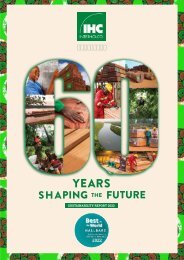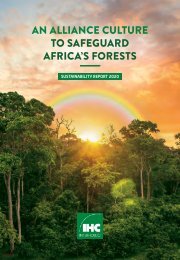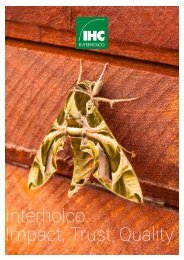Nomenclature Générale des Bois Tropicaux - 7ème édition
(english description below) Cette nomenclature est utilisée pour la mise à jour du 'Harmonized Code System' de l’Organisation Mondiale des Douanes. Dans la circulaire du 5 avril 2005, le Ministère de l’Economie, des Finances et de l’Industrie (France) reconnaît l’ATIBT comme « gardien du temple » de la nomenclature des bois tropicaux. La Commission Européenne mentionne la nomenclature de l’ATIBT comme document de référence pour la mise en œuvre du RBUE. Depuis 1954, l’ATIBT a établi et mis à jour une nomenclature des bois tropicaux faisant correspondre chaque espèce botanique avec un nom pilote reconnu internationalement. La détermination du nom pilote d’une essence est cruciale, car sa commercialisation dépend très largement de l’adoption de ce nom par le public. Le nom pilote assure la protection de l’appellation commerciale de l’essence et l’intégrité des propriétés qui lui sont attribuées, sans risque de confusion. The 1982 version of the general timber nomenclature has finally been updated as some of the 1,750 identified species, are no longer traded, while others, which were not previously included, are now on the market. The present revision has also integrated changes related to new taxonomy, in order to reflect the latest scientific developments. This Nomenclature has been used for the Harmonized Code System, updated by the World Customs Organization. The French Ministry of economy, finance and industry has given official recognition to ATIBT as the reference for the tropical timber nomenclature (NOR: PRMX0508285C of April 5th 2005). The European Commission refers to ATIBT nomenclature as a reference document for the implementation of the EUTR regulation. Since 1954, ATIBT has established and updated a nomenclature of tropical wood, linking each botanical species with an internationally recognized pilot name. A sigle wood species may have many common names; when trading across different countries, this may lead to confusion. Fixing the pilot name of a timber species is crucial, to protect the commercial denomination of the species and guarantee the veracity of the properties linked to that species, without confusion.
(english description below)
Cette nomenclature est utilisée pour la mise à jour du 'Harmonized Code System' de l’Organisation Mondiale des Douanes. Dans la circulaire du 5 avril 2005, le Ministère de l’Economie, des Finances et de l’Industrie (France) reconnaît l’ATIBT comme « gardien du temple » de la nomenclature des bois tropicaux. La Commission Européenne mentionne la nomenclature de l’ATIBT comme document de référence pour la mise en œuvre du RBUE.
Depuis 1954, l’ATIBT a établi et mis à jour une nomenclature des bois tropicaux faisant correspondre chaque espèce botanique avec un nom pilote reconnu internationalement. La détermination du nom pilote d’une essence est cruciale, car sa commercialisation dépend très largement de l’adoption de ce nom par le public. Le nom pilote assure la protection de l’appellation commerciale de l’essence et l’intégrité des propriétés qui lui sont attribuées, sans risque de confusion.
The 1982 version of the general timber nomenclature has finally been updated as some of the 1,750 identified species, are no longer traded, while others, which were not previously included, are now on the market. The present revision has also integrated changes related to new taxonomy, in order to reflect the latest scientific developments.
This Nomenclature has been used for the Harmonized Code System, updated by the World Customs Organization. The French Ministry of economy, finance and industry has given official recognition to ATIBT as the reference for the tropical timber nomenclature (NOR: PRMX0508285C of April 5th 2005). The European Commission refers to ATIBT nomenclature as a reference document for the implementation of the EUTR regulation.
Since 1954, ATIBT has established and updated a nomenclature of tropical wood, linking each botanical species with an internationally recognized pilot name. A sigle wood species may have many common names; when trading across different countries, this may lead to confusion. Fixing the pilot name of a timber species is crucial, to protect the commercial denomination of the species and guarantee the veracity of the properties linked to that species, without confusion.
Create successful ePaper yourself
Turn your PDF publications into a flip-book with our unique Google optimized e-Paper software.
Liste des noms scientifiques des bois tropicaux avec renvoi au nom pilote /// 35
NOM BOTANIQUE
BOTANICAL NAME
FAMILLE
FAMILY
CONTI-
NENT
Musanga cecropioides R. Br. Urticaceae (Cecropiaceae) AF Parasolier
Myristica spp. Myristicaceae AS Penarahan
Myristica maingayi Hook. f. Myristicaceae AS Penarahan
Myrocarpus fastigiatus Fr. All. Leguminosae (Fabaceae) AM Cabreùva
Myrocarpus frondosus Fr. All. Leguminosae (Fabaceae) AM Cabreùva
Myroxylon balsamum Harms Leguminosae (Fabaceae) AM Balsamo
Myroxylon peruiferum L. Leguminosae (Fabaceae) AM Balsamo
Myroxylon toluiferum H.B.K. (cf. M.balsamum) Leguminosae (Fabaceae) AM Balsamo
Myrsine guianensis Kuntze Primulaceae AM Canelón
Nageia spp. Podocarpaceae AS Podocarp
Nageia motleyi de Laub. Podocarpaceae AS Podocarp
Nageia vitiensis Kuntze Podocarpaceae AS Podocarp
Nageia wallichiana Kuntze Podocarpaceae AS Podocarp
Nauclea p.p. (AS) Rubiaceae AS Bangkal
Nauclea diderrichii Merr. Rubiaceae AF Bilinga
Nauclea gilletii Merr. Rubiaceae AF Bilinga
Nauclea officinalis Merr. & Chun Rubiaceae AS Bangkal
Nauclea orientalis L. Rubiaceae AS Bangkal
Nauclea trillesii Merr. (cf. N.diderrichii) Rubiaceae AF Bilinga
Nauclea xanthoxylon Aubrév. Rubiaceae AF Bilinga
Nectandra elaiophora Barb. Rodr. (cf. Ocotea
cymbarum)
NOM PILOTE
PILOT NAME
Lauraceae AM Louro branco
Neesia spp. Malvaceae (Bombacaceae) AS Durian
Neobalanocarpus heimii P.S. Ashton Dipterocarpaceae AS Chengal
Neolamarckia cadamba Bosser Rubiaceae AS Kadam
Neolamarckia macrophylla Bosser Rubiaceae AS Kadam
Neonauclea spp. Rubiaceae AS Bangkal
Neonauclea calycina Merr. Rubiaceae AS Bangkal
Neonauclea excelsa Merr. Rubiaceae AS Bangkal
Neonauclea lanceolata Merr. Rubiaceae AS Bangkal
Nesogordonia fouassieri Capuron Malvaceae (Sterculiaceae) AF Kotibé
Nesogordonia kabingaensis Capuron Malvaceae (Sterculiaceae) AF Kotibé
Nesogordonia leplaei Capuron Malvaceae (Sterculiaceae) AF Kotibé
Nesogordonia papaverifera Capuron Malvaceae (Sterculiaceae) AF Kotibé
Newtonia buchananii Gilbert & Boutique Leguminosae (Mimosaceae) AF Mafamuti
Newtonia leucocarpa Gilbert & Boutique Leguminosae (Mimosaceae) AF Ossimiale
Newtonia suaveolens Brenan (cf. Pseudopiptadenia
suaveolens)
Leguminosae (Mimosaceae) AM Timborana
Nothofagus spp. (AS) Nothofagaceae AS New-Guinea Beech
Nothofagus alpina Oerst. Nothofagaceae AM Rauli
Nothofagus dombeyi Blume Nothofagaceae AM Coigüe
Nothofagus grandis Steenis Nothofagaceae AS New-Guinea Beech














